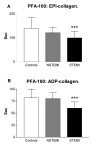Resistance to aspirin is increased by ST-elevation myocardial infarction and correlates with adenosine diphosphate levels
- PMID: 16045804
- PMCID: PMC1192820
- DOI: 10.1186/1477-9560-3-10
Resistance to aspirin is increased by ST-elevation myocardial infarction and correlates with adenosine diphosphate levels
Abstract
Background: To be fully activated platelets are dependent on two positive feedback loops; the formation of thromboxane A2 by cyclooxygenase in the platelets and the release of ADP. We wanted to evaluate the effect of aspirin on platelet function in patients with acute coronary syndromes and we hypothesized that increased levels of ADP in patients with acute coronary syndromes could contribute to aspirin resistance.
Methods: Platelet activity in 135 patients admitted for chest pain was assessed with PFA-100. An epinephrine-collagen cartridge (EPI-COLL) was used for the detection of aspirin resistance together with an ADP-collagen cartridge (ADP-COLL). ADP was measured with hplc from antecubital vein samples. Three subgroups were compared: chest pain with no sign of cardiac disease (NCD), NonST-elevation myocardial infarction (NSTEMI) and STEMI.
Results: Platelet activation was increased for the STEMI group compared NCD. Aspirin resistance defined as <193 sec in EPI-COLL was 9.7 % in NCD, and increased to 26.0 % (n.s.) in NSTEMI and 83.3 % (p < 0.001) in STEMI. Chronic aspirin treatment significantly reduced platelet aggregation in NCD and NSTEMI, but it had no effect in STEMI. Plasma levels of ADP were markedly increased in STEMI (905 +/- 721 nmol/l, p < 0.01), but not in NSTEMI (317 +/- 245), compared to NCD (334 +/- 271, mean +/- SD). ADP levels correlated with increased platelet activity measured with ADP-COLL (r = -0.30, p < 0.05). Aspirin resistant patients (EPI-COLL < 193 sec) had higher ADP levels compared to aspirin responders (734 +/- 807 vs. 282 +/- 187 nmol/l, mean +/- SD, p < 0.05).
Conclusion: Platelets are activated and aspirin resistance is more frequent in STEMI, probably due to a general activation of platelets. ADP levels are increased in STEMI and correlates with platelet activation. Increased levels of ADP could be one reason for increased platelet activity and aspirin resistance.
Figures




References
LinkOut - more resources
Full Text Sources
Medical
Miscellaneous

